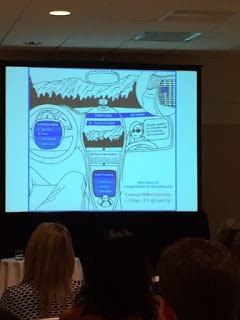@SouthernGrowth
Tethering the Void between Moonshot Ideas and Customer Connection

Tethering the Void between
Moonshot Ideas and Customer Connection
Moonshot Ideas and Customer Connection
Donna
Sturgess, Executive in Residence, Carnegie Mellon University
Sturgess, Executive in Residence, Carnegie Mellon University
'I've
been spending a lot of time in the future,' is how Sturgess opened this
evocative session. 'Things get funded at Carnegie Mellon for big, breakthrough
ideas, exponential innovations.'
been spending a lot of time in the future,' is how Sturgess opened this
evocative session. 'Things get funded at Carnegie Mellon for big, breakthrough
ideas, exponential innovations.'
Moonshot ideas is the recurring theme, bringing the future to life is the goal.
'Technology
runs far ahead of the customer'and the sweet spot is relevance and
shape-shifting technology.'
runs far ahead of the customer'and the sweet spot is relevance and
shape-shifting technology.'
Here
are two examples: Self-driving cars and big data.
are two examples: Self-driving cars and big data.
Self-driving cars
The
concept for autonomous vehicles began in 1939, but the ones we know began in
1984. This concept has been brewing for a long time.
concept for autonomous vehicles began in 1939, but the ones we know began in
1984. This concept has been brewing for a long time.
'This
car can drive from Pittsburg to Seattle without a human,' said Sturgess,
showing a Cadillac. 'We only need humans to fill gas and change oil.' We took
it to Washington where there is concern about traffic patterns many years from
now.
car can drive from Pittsburg to Seattle without a human,' said Sturgess,
showing a Cadillac. 'We only need humans to fill gas and change oil.' We took
it to Washington where there is concern about traffic patterns many years from
now.
The
cars are here, but policies are keeping them from being on the road. Yet,
Congress realized the technology is ready.
cars are here, but policies are keeping them from being on the road. Yet,
Congress realized the technology is ready.
One
driving question is 'what do people want in a self-driving car'? Here surveyed
1,000 people. Here are some of the responses:
driving question is 'what do people want in a self-driving car'? Here surveyed
1,000 people. Here are some of the responses:
1. Want to connect to home
system
system
2. Want my car to be designed
like an office
like an office
3. Want my car to be a mobile
medical office
medical office
4. Want a have a party car.
Understanding
the context helps design the experience. Yet, people have to see the future to
believe in it.
the context helps design the experience. Yet, people have to see the future to
believe in it.
Big Data
Big
data versus little data. 'The moonshot here is how advanced sensors can be. How
specific can the use be? For example, if we add sensors in devices to be
mindful when elderly people fall, it would be a win.'
data versus little data. 'The moonshot here is how advanced sensors can be. How
specific can the use be? For example, if we add sensors in devices to be
mindful when elderly people fall, it would be a win.'
There
is an 'enormous hunger' for services and product for sensors and the elderly.
is an 'enormous hunger' for services and product for sensors and the elderly.
Perhaps
sensors can be used with infants, too. 'how can sensors add real value'?
sensors can be used with infants, too. 'how can sensors add real value'?
In
this case, the sensor can measure your gait and let you know that you are moving
toward a condition to anticipate falls.
this case, the sensor can measure your gait and let you know that you are moving
toward a condition to anticipate falls.
Zooming
out, Sturgess claims that the public is not open to the quantum speed of
innovation. 'I feel pressure where the future is being created, but we haven't
defined what kind of future we want.'
out, Sturgess claims that the public is not open to the quantum speed of
innovation. 'I feel pressure where the future is being created, but we haven't
defined what kind of future we want.'
'Not
until you are willing to abandon your world view, can you see new mental
models,' she warns.
until you are willing to abandon your world view, can you see new mental
models,' she warns.
There
is a correlation in between the earth and the moonshot ideas. This gulf between the two is the road to opportunity.
is a correlation in between the earth and the moonshot ideas. This gulf between the two is the road to opportunity.
Michael Graber is the
managing partner of the Southern Growth Studio, an innovation and strategic
growth firm based in Memphis, TN and the author of Going Electric. Visit www.southerngrowthstudio.com to learn more.
managing partner of the Southern Growth Studio, an innovation and strategic
growth firm based in Memphis, TN and the author of Going Electric. Visit www.southerngrowthstudio.com to learn more.
